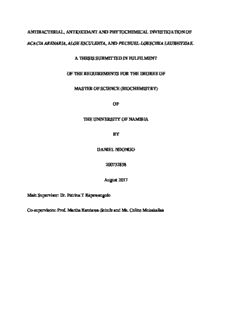
antibacterial, antioxidant and phytochemical investigation of acacia arenaria, aloe esculenta, and PDF
Preview antibacterial, antioxidant and phytochemical investigation of acacia arenaria, aloe esculenta, and
ANTIBACTERIAL, ANTIOXIDANT AND PHYTOCHEMICAL INVESTIGATION OF ACACIA ARENARIA, ALOE ESCULENTA, AND PECHUEL-LOESCHEA LEUBNITZIAE. A THESIS SUBMITTED IN FULFILMENT OF THE REGUIREMENTS FOR THE DEGREE OF MASTER OF SCIENCE (BIOCHEMISTRY) OF THE UNIVERSITY OF NAMIBIA BY DANIEL NDONGO 200732838 August 2017 Main Supervisor: Dr. Petrina T Kapewangolo Co-supervisors: Prof. Martha Kandawa-Schulz and Ms. Celine Mukakalisa ABSTRACT Natural products present in medicinal plants are an important source of therapeutic agents and many research groups are currently screening different biological activities of plants. This study aimed to investigate the antibacterial, antioxidant properties and phytochemical analysis of Acacia arenaria (Fabaceae), Aloe esculenta (Alliaceae) and Pechuel-Loeschea leubnitziae (Asteraceae) that are used in traditional settings. The antimicrobial activity of the methanol-dichloromethane (DCM) (1:1) extracts of these medicinal plants were tested against Shigella sonnei (ATCC 25931), Serratia marcescens (ATCC 8100), Enterococcus faecalis (ATCC 7080) and Alcaligenes faecalis (ATCC 8750). The minimum inhibitory concentration (MIC) of the extracts against afore mentioned microbes were determined. The antioxidant activity of the extracts was determined using α, α-diphenyl-β-picrylhydrazyl (DPPH) radical scavenging and reducing power assays. The phytochemical analysis of A. arenaria, A. esculenta and P. leubnitziae was done using qualitative and quantitative phytochemical analysis. Extracts demonstrated anti-microbial activity against S. sonnei, A. faecalis, E. faecalis and S. marcescens. The best activity was recorded with A. arenaria leaves extract, with MIC values ranging from 0.1 to 5.0 mg/mL against all tested bacteria. All extracts exhibited antioxidant activity for both assay techniques. The antioxidant activity correlated with the quantitative phytochemical presence of phenolic content ranging from 0.5 ± 0.1 to 5.7 ± 0.1 mg of GAE/g extract obtained in the extracts as well as condensed tannins ranging from 0.1 ± 0.0 to 72.6 ± 0.0 mg of TAC/g extract. Qualitative phytochemical analysis showed the presence of steroids, terpenoids, saponins, flavonoids, anthraquinones, coumarins, alkaloids, phenols and tannins. The results obtained in the present study indicated that the leaves, stem and roots of A. esculenta, and A. arenaria, P. leubnitziae are potential sources of natural antioxidants ii and antimicrobials. Further studies could look into the characterization of the bioactive compounds present in these plants. iii Table of Contents Abstract...............................................................................................................................ii Table of Contents…………………………………………………………………………iv List of figures......................................................................................................................viii List of tables ......................................................................................................................x Acknowledgements ............................................................................................................xi Declaration..........................................................................................................................xii Dedication...........................................................................................................................xiii List of abbreviations............................................................................................................xiv INTRODUCTION…………………………………………………………………………1 1.1. Orientation of the study.................................................................................................1 1.2. Statement of the problem..............................................................................................2 1.3. Objectives of the study..................................................................................................3 1.4. Research hypothesis…..................................................................................................3 1.5. Significance of the study...............................................................................................4 LITERATURE REVIEW…………………………………………....................................5 2.1. Plant description, geographical location and scientific studies....................................5 2.2. Traditional uses of A. arenaria, A. esculenta and P. leubnitziae.................................9 2.3. Natural Products as source of drugs …………………………………………………10 2.4. Phytochemicals……………………………………………………………………….12 2.4.1. Phenolics …………………………………………………………………..13 iv 2.4.2. Flavonoids ………………………………………………………………....14 2.4.3. Alkaloids ………………………………………………………………......15 2.4.4. Terpenoids………………………………………………………………….16 2.4.5. Saponins ……………………………………………………………….......16 2.4.6. Tannins …………………………………………………………………….16 2.4.7. Anthraquinones ……………………………………………………………17 2.4.8. Coumarins………………………………………………………………….17 2.4.9. Steroids…………………………………………………………………….18 2.5. Oxidative stress...........................................................................................................19 2.5.1. Free radicals.................................................................................................19 2.5.2 The role of antioxidants in diseases prevention............................................22 2.6. α, α-Diphenyl-1-PicrylHydrazyl (DPPH) Radical .....................................................24 2.7. Reducing Power Assay……………….......................................................................26 2.8. Quantitative determination of phytochemicals ..........................................................26 2.8.1. Total phenolics content...............................................................................27 2.8.2. Total condensed tannins..............................................................................27 2.9. Phytochemicals as antibacterial agents......................................................................28 2.9.1. Shigella sonnei............................................................................................29 2.9.2 Alcaligenes faecalis ……………………………………………………... 30 2.9.3. Enterococcus faecalis…………………………………………………….30 2.9.4. Serratia marcescens……………………………………………………...31 v METHODS.....................................................................................................................33 3.1. Research design ......................................................................................................33 3.2. Plant specimen and collection.................................................................................33 3.3. Phytochemical screening.........................................................................................34 3.4. Extraction of dried powder samples........................................................................36 3.5. Quantitative phytochemicals analysis ………..…………………………………..36 3.5.1. Total Phenolic Content.............................................................................36 3.5.2. Total Condensed Tannins ........................................................................37 3.6. Antioxidant Activity...............................................................................................37 3.6.1. DPPH Radical Scavenging Activity Assay..............................................37 3.6.2. Reducing Power Assay ………………………………………………...38 3.7. Antibacterial Activity …………………………………………………………....38 3.7.1. Disc Diffusion Assay…………………………………………………...38 3.7.2. Minimum inhibitory concentration (MIC) ……………………..……...39 3.8. Data analysis .........................................................................................................39 RESULTS .....................................................................................................................40 4.1. Phytochemical screening ……...............................................................................40 4.2. Quantitative phytochemical analysis………………………………………….......41 4.2.1. Total Phenolic and total condensed tannins content…………………………….41 4.3. Antibacterial Activity results ……………………………………………………...43 4.3.1. Disc diffusion result……………………………………………………………...43 vi 4.3.2. MIC Data………...…………………………….………………………………...45 4.4. Antioxidant Activity results......................................................................................46 4.4.1 DPPH Assay results………………………………………………………46 4.4.2. Reducing Power Assay ……....………………………………………….51 DISCUSSION..................................................................................................................54 CONCLUSION………………………………………………………………………....58 RECOMMENDATIONS ................................................................................................59 REFERENCE LIST .........................................................................................................60 Appendix A: L-Ascorbic Acid Calibration Curve ……………………………………...79 Appendix B: Gallic Acid Calibration Curve………………..…………………………...80 Appendix C: Tannic Acid Calibration Curve……………………………………………81 Appendix D: Ethical clearance certificate……………………………………………….82 Appendix E: Research collecting/permit………………………………………………...83 Appendix F: Research permission letter…………………………………………………84 vii List of figures Figure 1: Acacia arenaria (whole plant)………………………………………………….6 Figure 2: Aloe esculenta (whole plant)……………………………………………………7 Figure 3: Pechuel-Loeschea leubnitziae (whole plant)……………………………………8 Figure 4: Example of major classes of flavonoids isolated from plants ………………..15 Figure 5: Core chemical structures of coumarins. A=simple coumarins, B= pyrano coumarins, C= furanocoumarins...........................................................................................................18 Figure 6: Structure of a typical steroid…………………………………………………...19 Figure 7: DPPH• free radical conversion to DPPH by anti-oxidant compound …………………………………………………………………………………………….25 Figure 8: Schematic research design flow diagram ………………………………………33 Figure 9: DPPH scavenging activity of A. arenaria’s roots, leaves and stem extracts as compare to Ascorbic Acid …………………………………………………………………………..47 Figure 10: DPPH scavenging activity of A. esculenta’s roots, leaves and stem extracts as compare to Ascorbic Acid …………………………………………………………………48 Figure 11: DPPH scavenging activity of P. leubnitziae roots, leaves and stem extracts as compared to Ascorbic Acid ………………………………………………………………..49 Figure 12: Reducing power activity of A. arenaria roots, leaves and stem extracts ………………………………………………………………………………………………51 Figure 13: Reducing power activity of A. esculenta roots, leaves and stem extracts ………………………………………………………………………………………………52 Figure 14: Reducing power activity of P. leibnitziae roots, leaves and stem extracts ……………………………………………………………………………….……………...53 Figure 15: L- Ascorbic Acid Calibration Curve ……………………………………………79 viii Figure 16: Gallic Acid Calibration Curve ………………………………………………….80 Figure 17: Tannic Acid Calibration Curve …………………………………………………81 ix List of tables Table 1: Phytochemical screening results A. esculenta, A. arenaria, and P. leubnitziae’s roots, stems and leaves …………………………………………………………..…………….....41 Table 2: Total phenolic content and total condensed tannins of leaves, roots and stem extract from A. arenaria, A. esculenta and P. leubnitziae …………………..……………………..42 Table 3: Antimicrobial screening of plants against A. faecalis (ATCC 8750), E. faecalis (ATCC 7080), S. sonnei (ATCC 25931) and S. marcescens (ATCC 8100) using disc diffusion method.………………………………………….………………………………………….44 Table 4: MIC values (mg/mL) as determined by the microdilution method ……...……….45 Table 5: DPPH free radicals A. arenaria, A. esculenta and P. leubnitziae leaves, roots and stem extracts ……………………………………..………………………………………………50 x
Description: